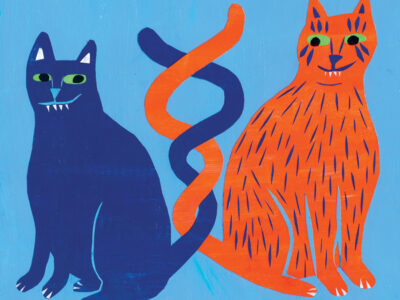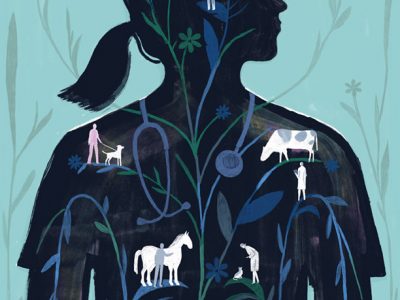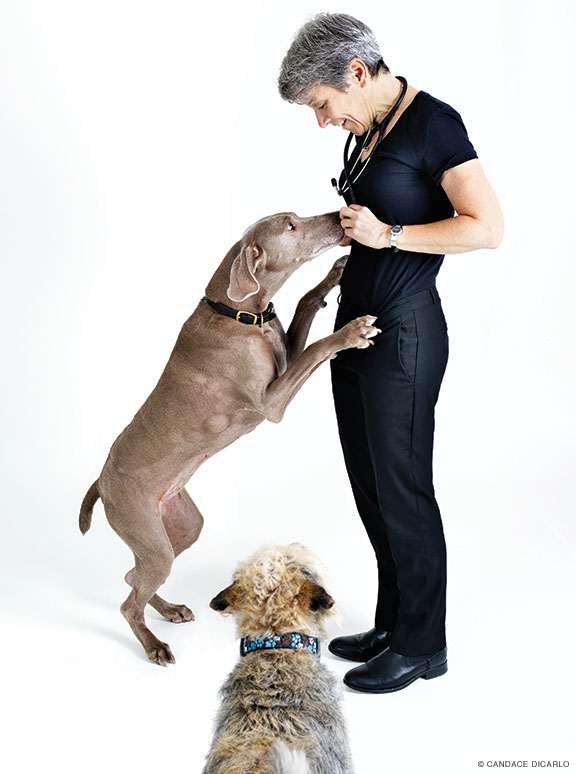
Drawing on groundbreaking immunotherapy techniques pioneered at Penn, the Vet School’s Nicola Mason is working toward a cure for bone cancer in dogs and children and to spark broader advances in the field of comparative medicine.
By Kathryn Levy Feldman | Photography by Candace diCarlo
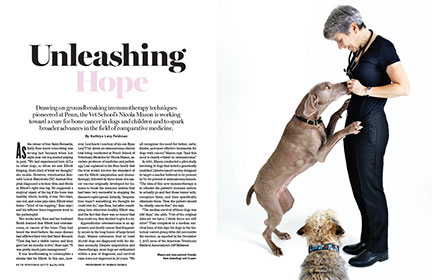
As the owner of four Saint Bernards, Kelly Buss knew something was wrong last January when her eight-year-old dog started yelping in pain. “We had experienced torn ACLs in other dogs, so when we saw Elliott limping, that’s kind of what we thought,” she recalls. However, veterinarian Kenneth Leal at Blairstown (NJ) Animal Hospital diagnosed a broken tibia and fibula in Elliott’s right rear leg. He suggested a surgical repair of the leg if the bone was healthy, which, luckily, it was. Two days, one rod, and some pins later, Elliott went home (“kind of toe-tapping,” Buss says) and his leftover bone fragments went to the pathologist.
Two weeks later, Buss and her husband Butch learned that Elliott had osteosarcoma, or cancer of the bone. They had heard the word before; the same disease had afflicted their very first Saint Bernard. “That dog had a visible tumor, and they gave her six months to live,” Buss says. “It was pretty much pain management.”
It was heartbreaking to contemplate a similar fate for Elliott. In this case, however, Leal knew (courtesy of his son Ryan Leal V’19) about an osteosarcoma clinical trial being conducted at Penn’s School of Veterinary Medicine by Nicola Mason, associate professor of medicine and pathology. Leal explained to the Buss family that the trial would involve the standard of care for Elliott (amputation and chemotherapy), followed by three doses of a cancer vaccine originally developed for humans to boost the immune system that had been very successful in stopping the disease’s rapid spread. Initially, “amputation wasn’t something we thought we could ever do,” says Buss, but after considering how otherwise healthy Elliott was, and the fact that there was no tumor that they could see, they decided to give it a try.
Appendicular osteosarcoma is an aggressive and deadly cancer that frequently occurs in the long bones of large-breed dogs. Mason estimates that at least 50,000 dogs are diagnosed with the disease annually. Despite amputation and chemotherapy, most dogs are euthanized within a year of diagnosis, and survival rates have not improved in 30 years. “We all recognize the need for better, safer, kinder, and more effective treatments for dogs with cancer,” Mason says. “And this need is clearly evident in osteosarcoma.”
In 2012, Mason conducted a pilot study involving 18 dogs that tested a genetically modified Listeria-based vaccine designed to target a marker believed to be present in 70–80 percent of osteosarcoma tumors. “The idea of this new immunotherapy is to educate the patient’s immune system to actually go and find those tumor cells, recognize them, and then specifically eliminate them. Then the patient should be, ideally, cancer-free,” she says.
“The median survival of those dogs was 956 days,” she adds. “Out of the original data set we have, I think three are still alive.” That compares to a median survival time of 423 days for dogs in the historical control group (who did not receive the vaccine), as reported in the December 1, 2017, issue of the American Veterinary Medical Association’s JAVMAnews.
In April 2018, Morris Animal Foundation awarded the University a $775,000 grant to test the vaccine in a controlled clinical trial in 80 dogs at Penn and 10 other top university-based veterinary centers across the United States. According to Kelly Diehl, the foundation’s senior director of science and communications, this ranks as one of the largest grants they’ve made in 50 years of funding cancer studies. “The results of the pilot study were so compelling that we knew we had to support this research team and their progression to a clinical trial.”
Besides having huge implications for treating this deadly disease in dogs, the clinical trial may also impact treatment for children with osteosarcoma, which accounts for 2 percent of all childhood cancers, affecting about 800 new kids per year in the US, according to the National Cancer Institute. Although not nearly as prevalent in children as in dogs, the diagnosis is equally devastating. The average five-year survival rate is roughly 70 percent with the standard treatment—amputation followed by chemotherapy and/or radiation—and there have been no new treatment options for humans in 30 years, says Mason.
Richard Womer, pediatric oncologist in the Cancer Center at Children’s Hospital of Philadelphia (CHOP), confirms this “frustrating” lack of progress. “The Children’s Oncology Group has conducted about 20 Phase II clinical trials since 2005, testing new drugs or combinations in patients with relapsed osteosarcoma in order to find new approaches to newly diagnosed patients,” he says. “None of these drugs or combinations has been found to be effective.”
“Osteosarcoma in dogs is almost identical to the cancer in children in every way: how it behaves, how it spreads, how it responds to certain chemotherapies,” Mason says. But there are differences as well. The disease occurs mostly in older dogs and large breeds like Saint Bernards, greyhounds, and wolfhounds, while in humans it usually affects a younger population and “the average height of human osteosarcoma patients is below average,” says Womer.
Most apparent across species is the need for new treatments. “It’s difficult to study rare or orphan diseases, so that’s where this whole idea of one medicine, one health is important,” Mason emphasizes. “We really believe that with these very positive results we’re seeing in the dogs, we might be able to translate that over into children. That would be incredibly important.”
About two and a half weeks after Elliott’s limb stabilizing surgery, Kelly and Butch Buss brought him to Penn Vet to determine if he qualified for the clinical trial. To be enrolled, dogs must be newly diagnosed with osteosarcoma and have received no prior treatment for the disease. They must weigh at least 55 pounds after amputation and the owners must be willing to pursue both amputation and chemotherapy (and cover associated costs of $5,000–$6,000) at Penn. Most important, dogs must show no evidence of metastasis at the time of enrollment. Costs for the vaccine, and follow-up chest X-rays and examinations are covered for qualifying dogs.
Since Mason has an intellectual property stake in the trial, James Perry, assistant professor of surgical oncology, serves as principal investigator on the clinical side of the study. On average, Perry says he sees “maybe 30 or 40” cases of osteosarcoma per year, and he is keenly aware of the time pressure associated with this aggressive and extremely painful cancer. “The longer the tumor is there, the higher the risk it could spread,” he says. “And that’s the thing with Nicky’s stuff. The surgery hasn’t changed much, but we’re trying to prevent the metastasis.”
One of the biggest challenges to treating osteosarcoma is its ability to metastasize very rapidly—and often undetectably, until it is too late. “While you can get rid of the primary tumor, cells have already peeled off that tumor and have gone around the body and are hiding somewhere,” says Mason. “These are the cells that are going to be responsible for relapse and cancer elsewhere.” She estimates that 90–95 percent of dogs with osteosarcoma have undetectable metastatic disease at presentation. Following chemotherapy, dogs typically have minimal signs of residual disease, and yet, according to Mason, most of these dogs eventually relapse with metastatic disease. “Clearly cancer is left after chemotherapy,” she notes.
Elliott ultimately met the criteria to participate, and the leg that had been surgically repaired was removed. He went home the next day. “It was amazing,” Buss recalls. “He was still kind of hobbling, but he seemed better. I remember the surgeon saying that you don’t think they are in pain, but they are. So that when that leg is removed, they feel better.”
Two weeks after his amputation, when his incision had healed and he was showing no sign of infection, Elliott began his chemotherapy with the drug carboplatin. “It’s anywhere between four and six treatments, and it’s three weeks between treatments,” explains Perry. Elliott had four rounds of chemotherapy and tolerated it very well. “Elliott was fine. He never lost his appetite. He never got sick,” says Buss. “It was really painless for all of us.”
Since deciding to become a veterinarian when she was “six or seven” growing up in Kent County, England, Mason has never thought of doing anything else. She blames her parents for her career choice, “because we were not allowed any animals when we were young. And when you are not allowed something, you always want it,” she laughs. After earning her degree from the Royal Veterinary College (part of the University of London) in 1992, in 1995 Mason came to Penn “straight off the boat” for her residency in internal medicine. She credits the influence of several veterinary school mentors who encouraged her to seek a residency program in the US, and she considers herself fortunate to have been at Penn ever since.
As an attending clinician, Mason saw “a number of cases associated with autoimmune diseases,” which she says sparked an interest “in why the immune system goes wrong.” That led her to decide to pursue a PhD in immunology, and in 1999 she was admitted to Penn’s program.
At that point, she had never worked in a lab before, and her first order of business was to find one that would take her for a rotation. After “trudging to four or five labs,” she came to one run by fellow Brit Yvonne Paterson, now a semi-retired professor of microbiology at the Perelman School of Medicine and scientific founder of Advaxis, a Penn-affiliated start-up biotechnology company. Having never “picked up a pipette,” as she puts it, Mason was prepared for another rejection, but “Yvonne said, ‘Well, that’s why you’re here: to learn,’” she recalls. So began a mentor/friend relationship that continues to this day.
Mason did her post-doctoral fellowship in the laboratory of Carl June, the Richard W. Vague Professor in Immunotherapy, director of the Center for Cellular Immunotherapies, and director of the Parker Institute for Cancer Immunology [“The T-Cell Warriors,” Mar|Apr 2015]. June is an internationally recognized HIV gene therapy pioneer, who developed CAR-T therapy, the nation’s first FDA-approved personal cellular therapy for cancer [“Gazetteer,” Nov|Dec 2017]. It was June’s research in translational medicine that furthered Mason’s interest in cancer immunology in dogs.
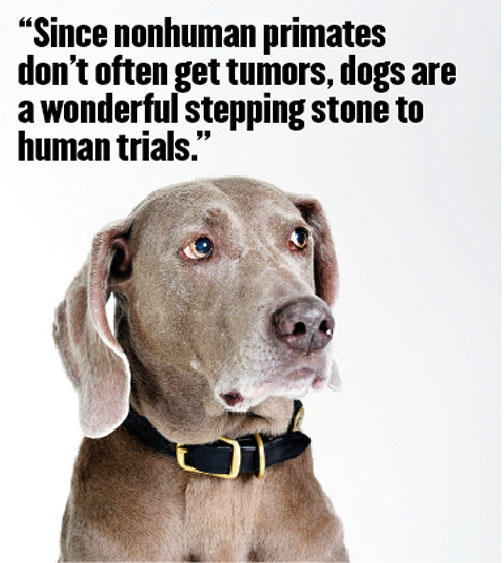
In 2007, Mason conducted a trial using a cell-based vaccine to treat canine lymphoma that was groundbreaking in treating the disease in dogs and has led to continued canine trials in precision medicine. “Research in comparative medicine has taken on increasing importance before testing new cell and gene therapies in humans,” June says. “Since nonhuman primates don’t often get tumors, dogs are a wonderful stepping stone to human trials. Dr. Mason is an international leader in developing this model.”
Shortly after Mason was appointed to the School of Veterinary Medicine’s faculty in 2011, Paterson invited her to give a talk at her lab. Mason was sharing her research on osteosarcoma in dogs—including the fact that the majority of canine cases over-express the genetic marker HER2/neu—when the eureka moment happened. “I immediately said, ‘I have a vaccine for that!’” Paterson recounts.
Paterson had what Mason calls “very compelling” data showing that a human HER2 vaccine she had developed worked in mice with the over-expressed marker. So “over a gin and tonic or three” they discussed launching a trial of the vaccine in dogs. “I think we started the trial because it was all in the family, so to speak,” Mason says.
“It was very unusual at the time and a very novel concept to me—we’re talking six to eight years ago,” Paterson adds. While using human therapy in dogs has become relatively common more recently, “then, I think it was probably one of the first studies to do so,” she says. “The idea of testing in dogs was something I hadn’t thought of until Nicky came and told us about the sarcoma in the dog. It was very fortuitous that we knew one another and that I followed up with her.”
The vaccine was developed at Advaxis, based on a genetically modified version of listeria (a bacteria that can cause food poisoning) that Paterson had developed to fight breast and other cancers with the HER2/neu marker. Paterson, a breast cancer survivor, had been testing the rodent version of the antigen in mouse models for breast cancer. The vaccine triggers an immune response to fight those over-expressed cells.
“The bacteria has been altered so that it’s very weak and it’s very easy for the body to eliminate so it doesn’t cause sickness,” Mason explains. “And it’s been further genetically modified to carry a portion of the tumor, a protein that the tumor expresses. So that if you think about it, you have a live bacteria that actually expresses a protein that’s found in your tumor. The whole thing looks like listeria to your immune system, so as soon as you put that into the body, the body says, ‘Oh here’s a bacteria I need to get rid of.’ So, of course, that listeria is expressing part of your tumor.”
Adds Paterson: “In theory, this could be used against virtually any cancer.”
Paterson thought they should use the human version, which was entering clinical trials, in dogs. As its scientific founder, Paterson licensed all her patents to Advaxis, and today serves as a consultant. She makes it very clear she was never a formal employee of the company, but admits that her presence didn’t hurt their case when she and Mason pitched the idea of the pilot study in dogs to its investors. For her part, Mason recalls that one of the investors she spoke with had a Leonberger (giant breed of dog) who had died from osteosarcoma and was eager to fund a new treatment. “Most drug companies say no because they’re worried that the data we might produce in the dogs might have a negative effect on their drug,” Mason notes. “So it’s very hard, and you need companies that have vision.”
Testing the vaccine on dogs offered the researchers the opportunity to assess the effectiveness and safety of the immunotherapy protocol (in early developmental stages) in a patient population (as opposed to an engineered mouse model) with spontaneously occurring cancer.
“It’s very important to have another way to evaluate these therapies than [just] in mice,” says Mason. “It makes sense because dogs are much closer to humans than laboratory animals,” Paterson adds. “They share our environment and eat many of our foods.” And they develop many of our same cancers.
The field of comparative oncology, which studies cancer risk and tumor development across species, has been around since the early 2000s and has made great strides in advancing both human and animal health. In 2003, the NIH recognized the potential of such collaborative research advancing human and animal health, naming its first director of the Comparative Oncology Program at the National Cancer Institute. Current Director Amy LeBlanc, a veterinary oncologist, oversees and manages the operations of the Comparative Oncology Trials Consortium, which executes and designs clinical trials of new cancer therapies in tumor-bearing pet dogs, including the one currently testing the Listeria HER2 vaccine. “Our support is being provided in kind by the NCI, but the government is not funding that trial as far as the clinical management of the dogs,” she notes. “Morris Animal Foundation is paying the bill, so to speak.”
Having been “in the trenches,” LeBlanc knows firsthand the importance of enrolling dogs in clinical trials and generating sound data. “I think it helps me get a good perspective on how to create good trials and work with drug development people, companies and [funders] like Morris, and people like Nicky to really make sure that whatever we do is poised to be impactful,” she says.
The commitment of owners who bring their dogs to veterinary schools is another key ingredient. “They are there, they are willing to usually go the distance,” LeBlanc says. And unlike in human medicine, “where you can’t really enroll in a clinical trial until you have failed the standard of care,” she continues, “in veterinary oncology, you can present an experimental clinical trial, upfront, along with other things.”
Dogs’ shorter life spans means that they tend to generate data more quickly in clinical trials than humans do, which is of great value to the pharmaceutical industry. “It takes time to actually see the trajectory of a drug percolating through all the standard testing before it winds up being assessed in people,” says LeBlanc. “It really has just been the last few years when we’ve had the ability to look at really nice datasets that were accumulated within dogs and within other preclinical animals and now within humans to have a side-by-side assessment of how powerful the dog data can be.
“And it’s because of Nicky and others working with us that we are poised to demonstrate to the pharmaceutical industry and the Food and Drug Administration that we have an opportunity to significantly contribute and optimize drug development activities, so we can save time and save money and help advance promising therapies quicker into humans and dogs.”
LeBlanc is quick to note that her organization is not advocating that dogs replace any other animal species testing mandated by law by the FDA for safety and tolerability. “We think maybe we can complement those studies,” she says, “perhaps making it possible for fewer numbers of those other animals to be assessed by looking at a comparative oncology study alongside them.
“Studies like what we are doing with Nicky … also benefit patient populations that may not get as much of a billing,” she adds. “Pediatric spaces are not as popular because there aren’t as many patients and companies are focused on big-ticket cancers. That’s another opportunity for us to make an impact.”
About three weeks after Elliott’s last chemo treatment, he received his first dose of the listeria-based vaccine. As Mason explains, dogs in the study typically arrive in the morning, have blood drawn to make sure they are healthy enough to receive the vaccine, and, if all is well, receive a half-hour intravenous infusion of the vaccine. “And then we watch them,” she says. Usually within two to four hours, the dog’s temperature will go up, an indication that the immune system has been activated. The dog may not feel very well at that point, although Mason says they still get up and go for a walk. Some experience nausea and one or two episodes of vomiting. Then their temperature comes down and by 6 p.m. they eat something and then go home.
“The thought is that it is rather similar to having a flu infection,” Mason says. “You’ve got lots of immune active molecules, cytokines, flying around your body and you feel a bit achy. But many of the dogs don’t even feel that. They do drink a lot of water after it for a day or so, but most of them don’t even skip a meal.”
Elliott fit the pattern, but because of the distance his owners traveled, he stayed overnight so he could be monitored. Buss recalls that after the second infusion he developed a little bit of a heart arrhythmia, which was treated with medication and then corrected. He finished up his third vaccine toward the end of July and had a follow-up appointment eight weeks later, where everything checked out. And then it was just wait and see.
In March, Elliott had his yearly check up with his vet who had not seen him with three legs. “She watched him move around and said he looked happy and healthy,” recalls Buss. As soon as he had healed from the surgery, Elliott had resumed his work as a therapy dog and continued to visit schools, libraries and nursing homes once a week.
Unfortunately, in October Elliott succumbed to what at first appeared to be a heart attack but which the necropsy report showed was the spread of the osteosarcoma to the heart muscle. “We have seen osteosarcoma spread to the heart like this, but it is overall very rare,” Perry notes.
Despite their loss, Kelly and Butch Buss have no regrets. “We wanted to give Elliott a chance at life and the months we had were good quality ones. He knew he was loved and we know he loved us,” Kelly wrote in an email. “We thought it was worth trying. He tolerated treatment very well and I would probably do the same thing again. At least we know we gave him every chance.”
It’s still too early to comment on the study’s overall results. “The dogs are tolerating the therapy, but we won’t know until we get two or three years out if it made a difference in their longevity and their quality of life and other measurements,” say Morris Animal Foundation’s Kelly Diehl.
With regard to the human trial of the vaccine, Richard Gorlick, the head of the Division of Pediatrics at the MD Anderson Cancer Center who is overseeing the project, could only say the “the protocol is moving through the various steps needed to be developed, but is still at an intermediate stage in which it continues to evolve.” He did note that the use of the “agent in humans is definitely based on Mason’s work; the design is somewhat different from canines to humans, but it is related.”
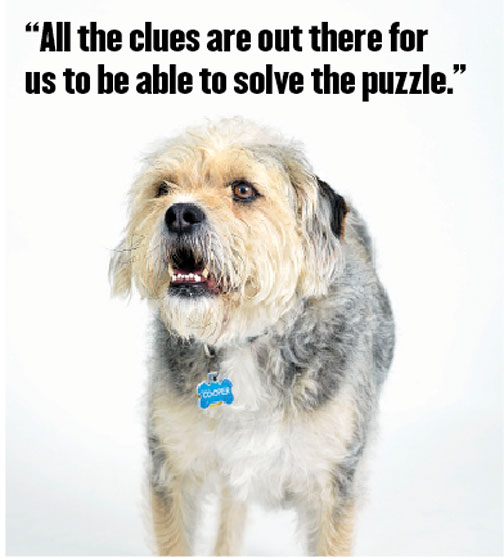
In addition to her work on osteosarcoma, Mason is continuing research in canine lymphoma, focusing on two different immune therapy approaches, currently in clinical trial stages. The first aims to prevent relapse in dogs that have been treated with chemotherapy. The second is for dogs who have already relapsed and are developing drug resistant disease. Both rely on T cells taken out of the blood, genetically modified in the lab, and returned to the patient as CAR-T cells. This approach has shown to be dramatically effective in humans and is now being adopted for dogs.
She is also working on another deadly canine disease—hemangiosarcoma, which affects the lining of blood vessels—by desequencing the tumors that are removed to determine what oncogenic drivers are present, which could lead to more targeted treatments. “I think we need to move away from saying, ‘This is how we treat hemangiosarcoma,’ and toward saying, ‘This is how we treat a tumor that has a specific mutation,’ because not all tumors are the same,” Mason says. “All the clues are out there for us to be able to solve the puzzle. It’s just a matter of mobilizing people, getting collaborations, developing the networks, getting the tissue to analyze, getting appropriate funding. And I think we have the brainpower on this planet to do that.”
In 2013, Mason and Paterson’s collaboration on the osteosarcoma vaccine earned them the University’s One Health Award, recognizing exemplary contributions toward expanding interdisciplinary education and improving health care for the benefit of humans, animals, and the environment. “I like this quote from Rudolf Virchow, a German pathologist in the 1800s. He said: ‘Between animal and human medicine, there are no dividing lines, nor should there be, and that’s the point,’” says Mason.
“It doesn’t make sense that on one side we study dog cancers and we’re vets; while on the other [side], doctors study humans and their cancers. There are smart people on both sides, and we have parallel patient populations. We can learn a lot from human medicine so that we can improve our treatment for the dogs. At the same time, human medicine can learn from what we do in our dogs. It goes both ways, and an example is the listeria vaccine. What we need are willing, collaborative individuals on both sides that recognize that we can do a lot more if we move forward together.”
Kathryn Levy Feldman LPS’09 has written previously for the Gazette on comparative oncology (“Saving Bentley,” Jul|Aug 2004; “A Double Reward,” Sep|Oct 2010) as well as a variety of other subjects.



